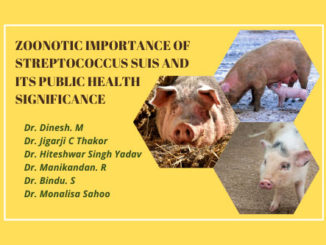History and Clinical Observations
A doe weighing 45 kg during last trimester of pregnancy was presented at Veterinary Hospital Chaumuha,Mathura with primary complaint of inappetance and recumbency for a week. The most prominent abnormality during clinical examination was weakness in both hind limbs presented by difficulty in standing. History and abdominal ballotment confirmed that the doe were about 4.5 months pregnant. Typical signs of hypocalcemia (“S” shaped posture, sternal recumbency) were seen. Besides that, ketone bodies were also detected from the urine (3+ or 8mmol/L).
The doe was managed intensively and was fed with cut herbs, pellets, brewer’s grains and supplemented with calcium suspension and a liver tonic. Further the vaccination and deworming status were not up-to-date. The doe was presented on sternal recumbency with body score of 3 out of 5. Clinical examination revealed pyrexia 39.8°C, dull depressed, lethargy, staggering gait and weakness of both hindlimbs.
Diagnosis
On the basis of history and clinical examination case is diagnosed as pregnancy toxaemia.
Treatment
- The main objective of treatments in pregnancy toxaemia is to increase the formation of glucose for utilization at tissue level, and increase the usage of ketone bodies to prevent acidosis and electrolytes disorder. However, treatments with drugs are only effective in an early disease diagnosis where prognosis is always grave if the animals start showing irreversible neurological injuries .
- The doe was aggressively treated for pregnancy toxemia with administration of 1 liter of 20% dextrose and 3 liter of normal saline BID IV for 3 days.
- 30ml of glycerine (Enerdyna®) was also given orally BID for 3 days as glucose precursor.
- Along with aggressive fluid therapy supportive treatment was giving which includes flunixin meglumine @ 2.2mg/kg BW IM OD, multivitamin (Tribivet M®) @ 2ml IM OD, Phosphorus (Tonophos®) @ 3ml IM OD and antibiotic (Intacef®) @ 10mg/kg BW OD for 3 days.
- In addition, 100 ml of calcium borogluconate (Calborol®) was given slow intravenous (i/v) infusion and 50 ml calcium supplement was given orally for 5 days.
- However, the doe’s condition started to deteriorate on Day 3 and kidding was induced by giving 5ml of dexamethasone (Dexona®) intravenously on the same day and two live kids were born after 40 hours of induction.
- The doe’s condition improved tremendously and was kept on oral calcium and glucose therapy for a week thereafter. The goat recovered uneventfully.
Conclusion
- Pregnancy toxaemia is a metabolic disease of small ruminants and susceptibility is higher in dam with twin pregnancy.
- Negative energy balance between dam and foetuses predisposes the condition.
- Pregnancy toxaemia results from disruption of the glucose homeostatic mechanism in response to increased nutritional demands of rapidly developing foetuses.
- Early treatment is very crucial to save the life of the dam and the foetuses.
- Treatment is benefited from early investigation, which includes timely diagnosis and immediate administration of energy sources to affected animals.
- Induction of kidding/lambing in dam is helpful in fruitful recovery of pregnancy toxaemia if the condition of animal deteriorates severely.
| The content of the articles are accurate and true to the best of the author’s knowledge. It is not meant to substitute for diagnosis, prognosis, treatment, prescription, or formal and individualized advice from a veterinary medical professional. Animals exhibiting signs and symptoms of distress should be seen by a veterinarian immediately. |






Be the first to comment